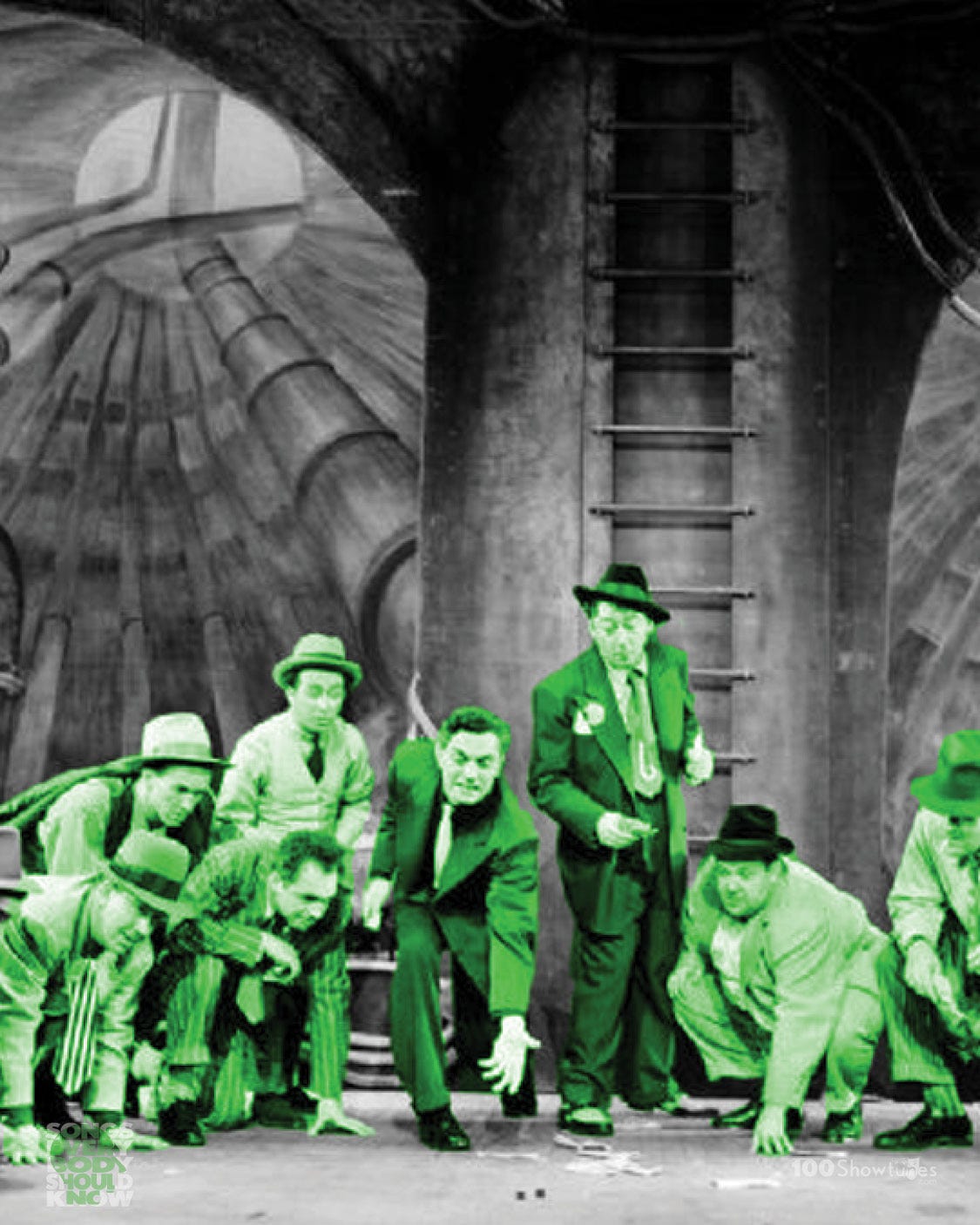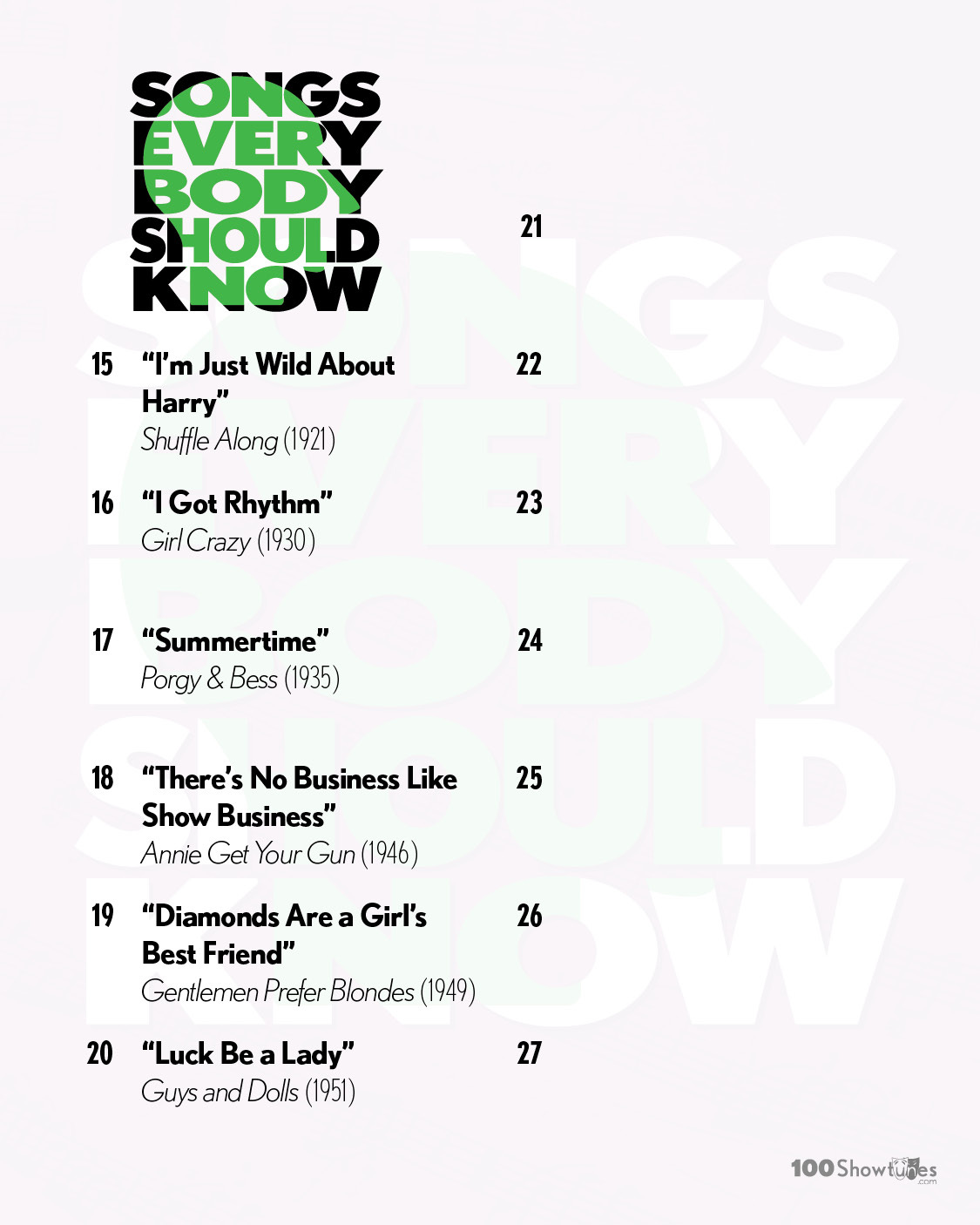No. 20. “Luck Be a Lady”
GUYS AND DOLLS (1950). By Frank Loesser (music and lyrics) and Abe Burrows & Jo Swerling (book). Based on a Story and Characters by Damon Runyon.
Winter, 1950. You’re watching Guys and Dolls: A Musical Fable of Broadway. It’s specifically a fable of Damon Runyon’s Broadway, which isn’t so much a theater district as it is a home for lovable gangsters with names like “Nicely Nicely Johnson” and “Harry the Horse.” A stylized opening ballet—choreographed by Michael Kidd—introduces the neighborhood denizens, and leads into a delightful fugue about horse racing. Nathan Detroit, the proprietor of “the oldest established permanent floating craps game in New York,” is perpetually on the hunt for a place to roll dice. His “doll” is Adelaide, a nightclub performer whose protracted engagement to Nathan leads to flu-like psy-co-so-ma-tic symptoms. Sky Masterson is an infamous high-roller with a habit for unconventional bets. Nathan proposes a $1,000 wager: Sky must take a woman of Nathan’s choosing for dinner in Havana. The “doll” Nathan chooses for Sky is Sarah Brown, the leader of a Save-a-Soul Mission under threat of closure due to a lack of souls saved. Sky and Sarah fall in love, only for Sarah to realize at the act one curtain that she’s been an unwilling participant in Nathan and Sky’s gambling endeavors. The show flies by with compelling characters, snappy dialogue, and a fantastic score by Frank Loesser. In the second act, Nathan arranges a craps game in set designer Jo Mielizner’s sexy interpretation of a sewer. Sky, wanting back in Sarah’s good graces, makes a bet: If Sky loses, he owes everybody $1,000. But if he wins, everybody in the sewer has to show up to a Save-a-Soul meeting that evening. As he prepares for this high-stakes roll, he sings ”Luck Be a Lady” (with killer choral support from the gamblers).
The most common adjective you’ll hear describing Guys and Dolls is “perfect.” The book equally balances the romantic Sky-Sarah and comedic Nathan-Adelaide stories and seamlessly integrates with the score. This feat hard enough to pull off in the best of circumstances, and when’s the last time a new musical saw the best of circumstances? Jo Swerling wrote a book to which Frank Loesser wrote most of the score. Loesser believed characters should sing like they talk, and the songs are loaded with personality and specifics. Swerling’s book proved unusable, and Abe Burrows had to write a new book around the largely existing score, but it all feels like it just came together naturally. (Swerling maintains a credit because he’s apparently better at contractual negotiations than bookwriting.) Beyond balancing two A-plots, G&D balances a tone that is both a send-up and sincere. Gangsters can break out into song in all sincerity, and it doesn’t feel ridiculous. Finally, a musical Dads WANT to see! Yes, it’s a PG version of the criminal underworld, but the threats and consequences have weight. “Luck Be a Lady” is the embodiment of G&D’s bravado, and became the anthem for Vegas Rat Pack aesthetic.
Recommended Recording: ”Luck Be a Lady,” Guys and Dolls (1992 Broadway Revival Cast)
Guys and Dolls is so well constructed that it’s almost impossible to screw it up if everyone knows their lines and can hit most of the notes. But if you know you can see a solid G&D at your local high school, what can a Broadway revival offer? The 1992 revival of Guys and Dolls, directed by Jerry Zaks, approached the piece like a new show, without relying on previous design or choreographic notions. Peter Gallagher brought some movie star power to the role of Sky Masterson—but by the time the show opened, the stars became the Broadway stalwarts in breakthrough performances as Nathan and Adelaide: Nathan Lane and Faith Prince. The revival was a smash hit, running two and a half years and setting the blueprint for the revival craze that came to dominate the 1990s. The excellent cast recording beautifully captures the richness of Loesser’s score and the stellar choral arrangements.
Alternate Performances
Guys and Dolls has received ~23 cast recordings, including international recordings (apparently in Italian it’s Bulli & Pupi, which is just adorable), a complete studio recording, and a “50th Anniversary Recording” with Maurice Hines. It was last seen on Broadway in a misguided 2009 revival. It’s been revived in London several times this century, most recently as an “immersive” production requiring the audience to move around to catch scenes on different platforms. (I don’t think G&D needs all that, but audiences seemed to enjoy it.) “Luck Be a Lady” has appeared in numerous TV shows and movies, including a memorable montage in the movie Mrs. Doubtfire
1951 Original Broadway Cast - This is one of THE classic cast recordings of a Golden Age musical. Even with the limitations of the era’s recording technology, the glory of the score, arrangements, and orchestrations shines through, with performances that have a more casual sincerity than the often effortful 1992 cast. (Even though the leading men aren’t really singers.)
1955 Film - Though not without some occasional charms (like some Michael Kidd choreography), the 1955 film adaptation of Guys and Dolls is one of Broadway’s most disappointing stage-to-screen transfers. Frank Sinatra was cast as the comedic Nathan Detroit, playing him as an unironically smooth operator that in no way contrasts with Sky Masterson. Marlon Brando played Masterson, requiring him to sing all the romantic ballads as well as “Luck Be a Lady.” If you find yourself thinking “I didn’t know Marlon Brando could sing,” please note that he could not. They cut five great songs and added three inexplicable duds. Frank Loesser allegedly refused to watch it throughout the rest of his life.
1976 Broadway Revival - Guys and Dolls frequently appeared in NYC in limited-run revivals throughout the 1950s and 1960s. A 1976 Broadway revival was the first to dramatically rethink the material, with an all black-cast and new musical arrangements with a 1970s Motown flair. The production was not tremendously successful, but the cast recording is absolutely delightful.
Is it Covered by The Rat Pack, Audra McDonald, or Glee?
The Rat Pack Frank Sinatra’s performance in the Guys and Dolls film wasn’t well received, and he didn’t sing “Luck Be a Lady.” But he had the last laugh by recording it in 1963 and turning it into one of his (and the Rat Pack’s) signature songs. Sammy Davis Jr. actually recorded “Luck Be a Lady” before Frank did, on a 4-song EP of covers tied in to the release of the G&D film.
Audra McDonald has not played Sarah Brown, which is a damn shame. Nor has she performed “Luck Be a Lady.” But she and Patti LuPone headlined a 2000 concert at the Hollywood Bowl (back when they were on speaking terms, I guess) where they sang Sarah and Adelaide’s act two duet, “Marry the Man Today.” Audra also sings “More I Cannot Wish You” on her Sing Happy album. “More I Cannot Wish You” is one of the loveliest songs in a show, sung by Sarah’s grandfather as he encourages her to follow her heart (even if that leads to a gambler). It doesn’t get a lot of love (because it’s slow and sung by someone who’s had like 4 lines up to that point), but it’s always been one of my favorites. I can only imaging that Audra recorded it specifically for me, so you’re welcome.
Glee never performed “Luck Be a Lady,” but “Sit Down You’re Rockin’ the Boat”—a great production number from the revival meeting at the Save-a-Soul Mission after Sky wins his bet—features prominently in the pilot. It’s the first song the newly assembled Glee Club tries to learn. Wheelchair-bound Artie (Kevin McHale) sings lead, which Rachel (Lea Michele) thinks is in poor taste. Mr. Shuster says he was being intentionally ironic in that casting, prompting Rachel to storm out saying “there’s nothing ironic about show choir!” The characters sing it again in “Goodbye” (season 3 episode 22) as many of the original kids look towards graduation.
In the Wings
Song No. 21 will drop next week. For more about Guys & Dolls, I highly recommend Jack Viertel’s book The Secret Life of the American Musical: How Broadway Shows Are Built. It’s an exploration of the primary types of songs that make musicals work, and it references G&D frequently and reverently. There’s also this 1992 documentary about making the cast recording for the 1992 G&D revival, as well as this A&E special about that production.




